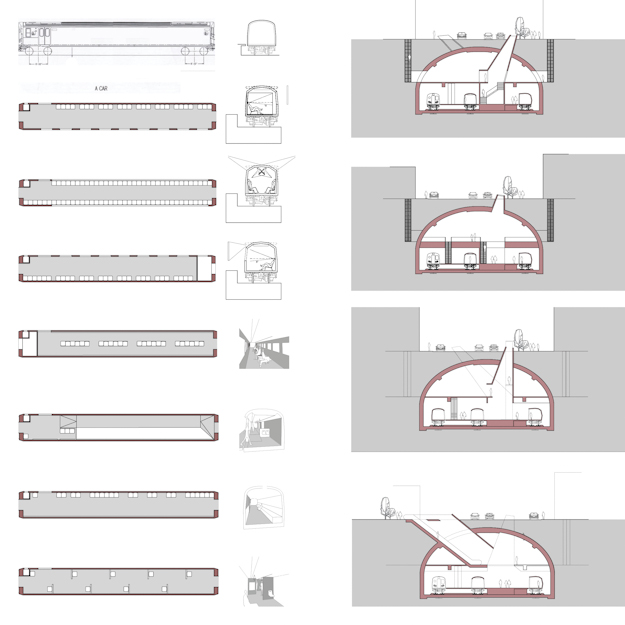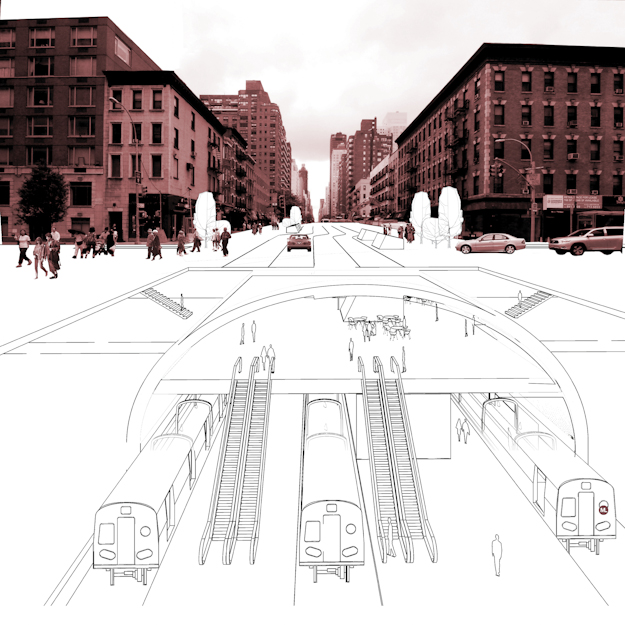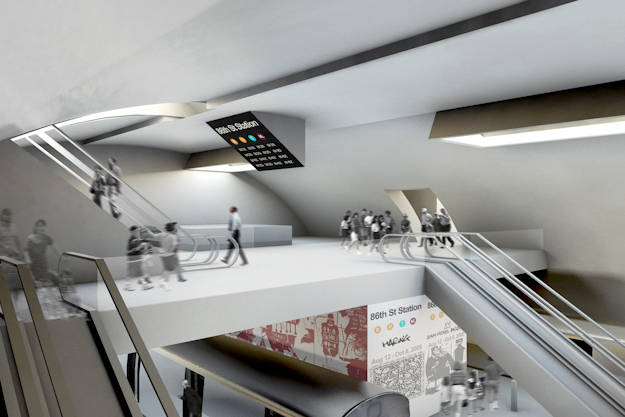MUSEUM LINE
Museum Line is an exploration of promising opportunity generated by the fusion of two prominent New York’s phenomena: Museum of Art and Subway Line. The idea of cross-programming the busiest public transportation system in the United States with experiencing art as-you go unveils possible benefits for both sides. Achieving an equal balance between quality of museum experience and subway culture is one of the crucial aspects of the project.
Based on the factual project of new line for the City of New York along the Second Avenue, the proposal conforms to all existing constraints of the site. The number of tracks, shape and dimensions of the tunnel and surface traffic as well as light studies of the underground spaces have been factored into the design. In addition, the proposal creates unique linear park on the surface along the line.
Project is based in New York City utilizing all three stations of the already-started first phase of the proposed Second Avenue Subway. The Museum Line Train oscillates between 72nd Street Station and 96th Street Station. 86th Street Station in the center is developed as a central hub. Its unique semicircular tunnel construction allows for galleries and double-height public spaces. Transfer from and to local trains is available from all three stations. Museum Line is stretches along the first portion of the future line, it is however, imagined to grow and eventually connect New York City from Hannover Sq to 125th Street becoming a unique cultural link.
Movement of the train offers range of uses and adaptations exploitable by museum program. 12 frames per second, a minimum amount of frames for human eye to perceive series of images as motion picture, is achieved for frame size 3◊2 feet by moving 20mph. Direct translation to subway environment is achieved by placing series of frames on the sidewall of the tunnel. Furthermore, by inverting the concept of projection, series of static imagery from individual projectors attached to the tunnel becomes motion picture when the train ensemble achieves or exceeds the target speed.
A set of 8 subway cars is utilized as a complex exhibiting space for various forms of exhibiting art. Proposal uses the latest R174 Kawasaki cars designed for the newly constructed Second Avenue Subway Line.
The R174 Kawasaki car is 75í long and 9í2î wide. It provides 620 square feet of exhibit space. The cars are interconnected, free movement between moving cars is possible and encouraged.
For exhibit purposes two kinds of cars are designed. For medium to small artwork sizes, regular car is used with minimizing the amount of doors and windows to gain larger exhibit area. Adjusted cars adaptable to potential requirements are proposed with variable geometry complying with dimensions of the tunnel.
Museum Line is an exploration of promising opportunity generated by the fusion of two prominent New York’s phenomena: Museum of Art and Subway Line. The idea of cross-programming the busiest public transportation system in the United States with experiencing art as-you go unveils possible benefits for both sides. Achieving an equal balance between quality of museum experience and subway culture is one of the crucial aspects of the project.
Based on the factual project of new line for the City of New York along the Second Avenue, the proposal conforms to all existing constraints of the site. The number of tracks, shape and dimensions of the tunnel and surface traffic as well as light studies of the underground spaces have been factored into the design. In addition, the proposal creates unique linear park on the surface along the line.
Project is based in New York City utilizing all three stations of the already-started first phase of the proposed Second Avenue Subway. The Museum Line Train oscillates between 72nd Street Station and 96th Street Station. 86th Street Station in the center is developed as a central hub. Its unique semicircular tunnel construction allows for galleries and double-height public spaces. Transfer from and to local trains is available from all three stations. Museum Line is stretches along the first portion of the future line, it is however, imagined to grow and eventually connect New York City from Hannover Sq to 125th Street becoming a unique cultural link. Movement of the train offers range of uses and adaptations exploitable by museum program. 12 frames per second, a minimum amount of frames for human eye to perceive series of images as motion picture, is achieved for frame size 3◊2 feet by moving 20mph. Direct translation to subway environment is achieved by placing series of frames on the sidewall of the tunnel. Furthermore, by inverting the concept of projection, series of static imagery from individual projectors attached to the tunnel becomes motion picture when the train ensemble achieves or exceeds the target speed.
A set of 8 subway cars is utilized as a complex exhibiting space for various forms of exhibiting art. Proposal uses the latest R174 Kawasaki cars designed for the newly constructed Second Avenue Subway Line.
The R174 Kawasaki car is 75í long and 9í2î wide. It provides 620 square feet of exhibit space. The cars are interconnected, free movement between moving cars is possible and encouraged.
For exhibit purposes two kinds of cars are designed. For medium to small artwork sizes, regular car is used with minimizing the amount of doors and windows to gain larger exhibit area. Adjusted cars adaptable to potential requirements are proposed with variable geometry complying with dimensions of the tunnel.
Location: Second Avenue Subway, New York City
Status: Competition 2010
Date:
2022-06-01
Category:
Building









